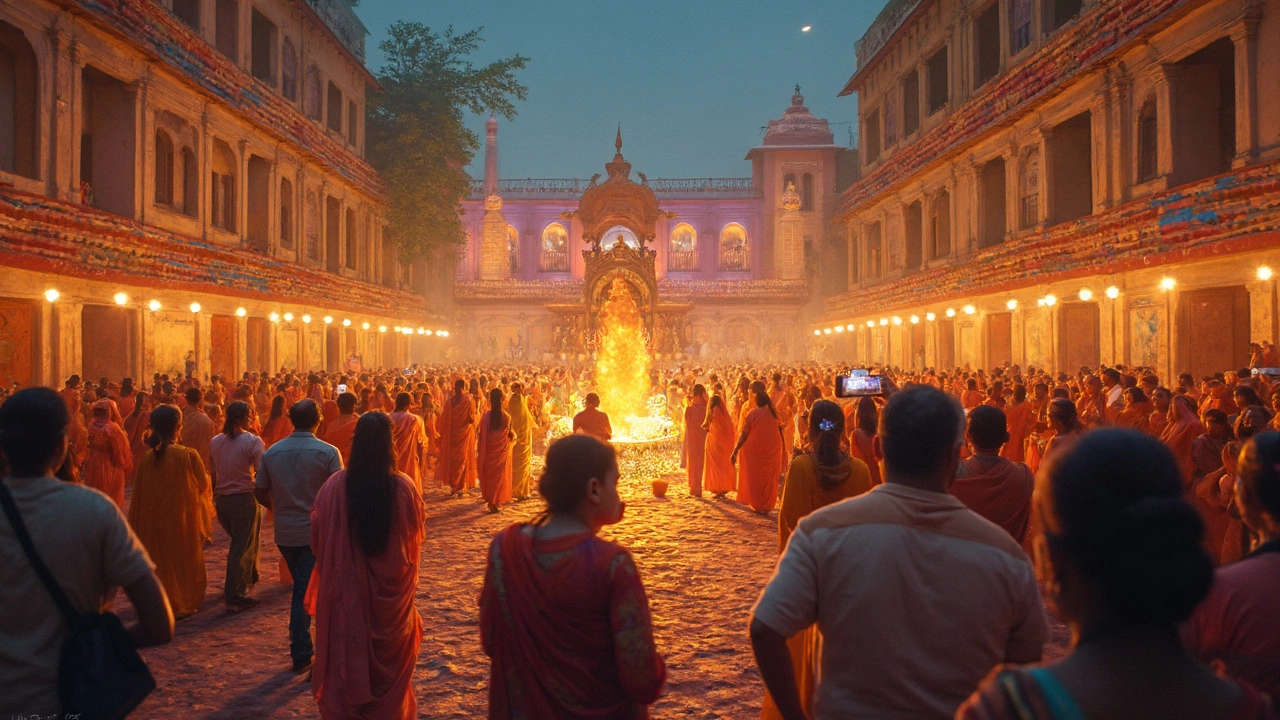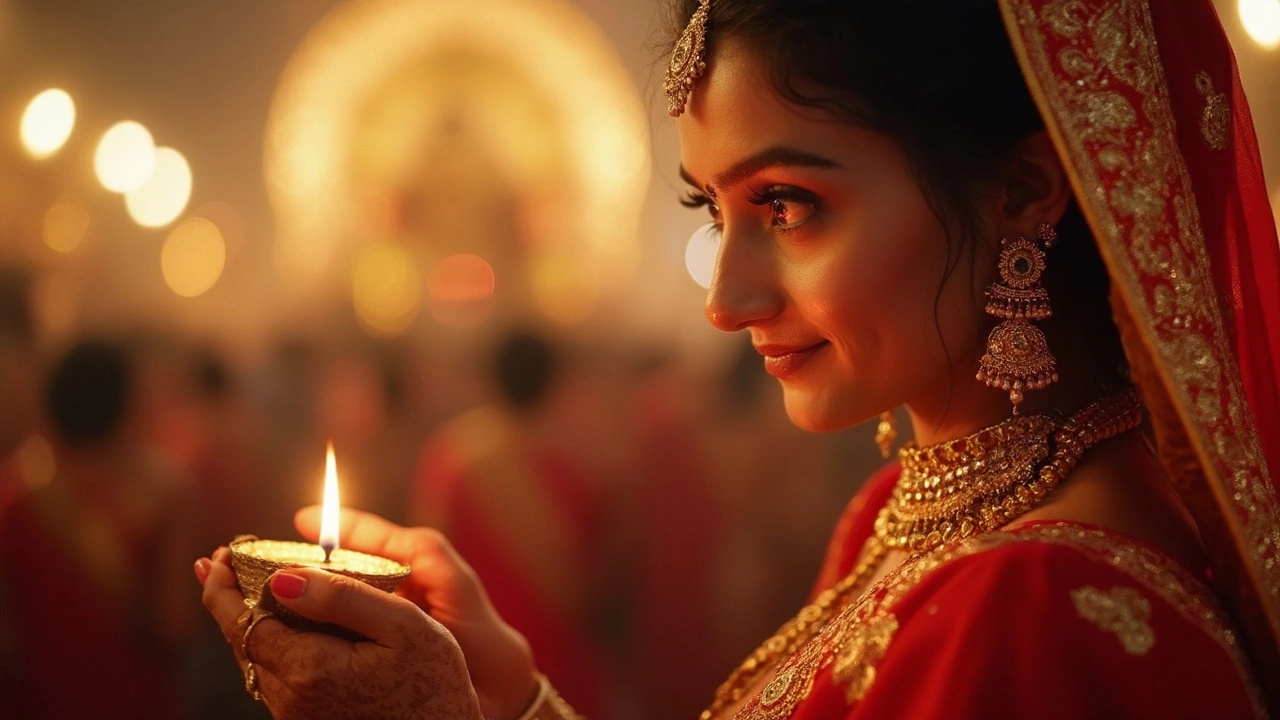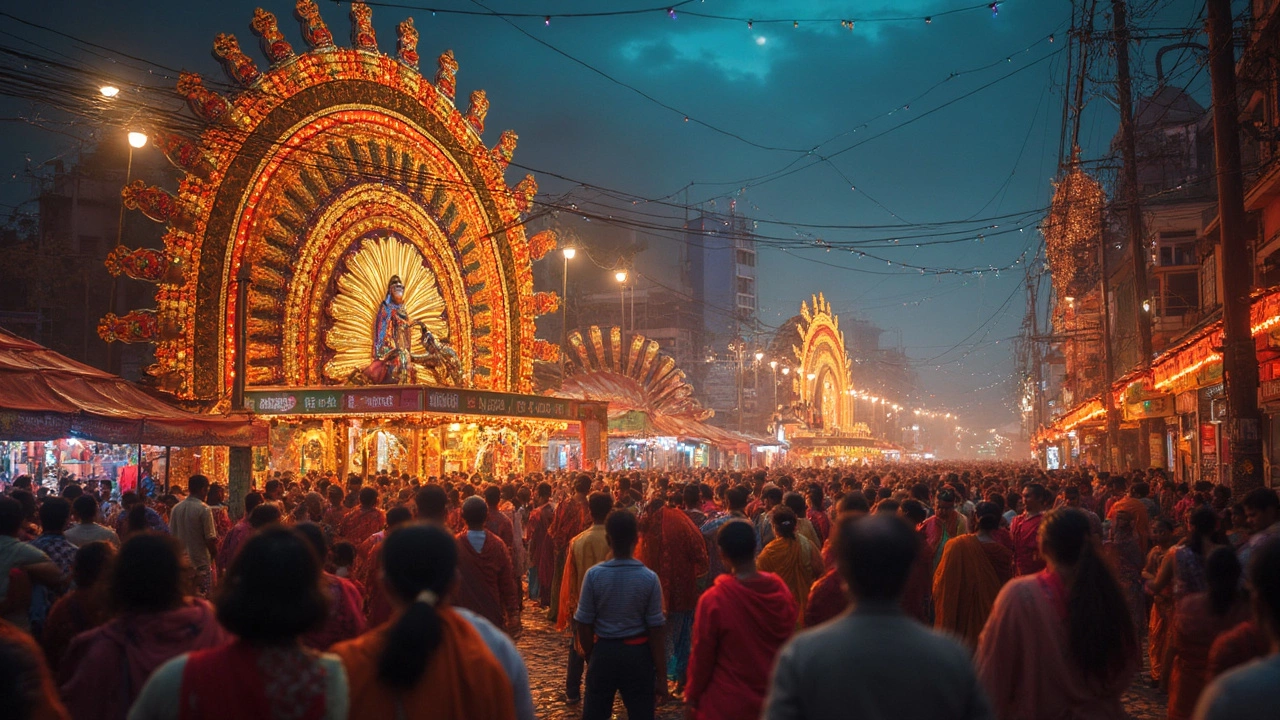When it comes to Bengali festivals, Durga Puja takes the crown—and for a good reason. It's not just any celebration; it's an extravaganza filled with devotion, artistry, and a genuine sense of community. Taking place every year during the autumn, usually around September or October, this festival marks the victory of the goddess Durga over the evil buffalo demon, Mahishasura.
It's not just about religious rituals, though they are a big part of it. The whole region transforms into a vibrant tapestry of colors, music, and delicious food. Imagine streets lined with stunning pandals (temporary structures) housing intricate statues of goddess Durga, each telling a unique story. It's a visual and sensory feast like no other.
- The Legend of Durga Puja
- How Bengalis Celebrate
- Cultural Significance
- Experiencing the Festivities
- Modern Touches to Tradition
The Legend of Durga Puja
The story behind Durga Puja is rooted deeply in both mythology and tradition. It traces back to ancient Hindu epics and conveys a powerful message of the eternal struggle between good and evil. The legend tells us about the mighty goddess Durga, created by the gods to vanquish the invincible demon king, Mahishasura, who had terrorized the heavens and the earth.
Mahishasura, thanks to a boon that made him immune to defeat by any man, seemed unstoppable. That's where the gods intervened. In a spectacular act of cosmic cooperation, each god contributed divine energy, and thus, Durga was born—armed with ten hands, each holding a formidable weapon. She rode into battle on a lion, showcasing strength and courage.
The battle between Durga and Mahishasura lasted for ten days, ending on the tenth day with Durga emerging victorious. This day is celebrated as 'Vijaya Dashami' and marks the conclusion of the festival, symbolizing the victory of good over evil.
Bengalis, in particular, revere Durga as 'Ma Durga,' the invincible mother goddess who protects her devotees from harm and ensures their welfare. The puja days signify not just religious observance but also social and cultural renewal.
Scriptural Significance
The legend of Durga and Mahishasura has strong roots in ancient scriptures like the Devi Mahatmya, which is a part of the Markandeya Purana. This text is recited during the festival, reminding everyone of the goddess's unparalleled strength and her role as a defender against chaos.
| Event | Significance |
|---|---|
| Mahayajna | A grand ritual to invoke Durga's blessings |
| Sandhi Puja | The critical 48 minutes when Durga achieved victory |
Each phase of the Bengali festival carries its own weight and reflection of this profound legend, making Durga Puja not just a festival, but a poignant reminder of the power of good to triumph over evil.
How Bengalis Celebrate
During Durga Puja, Bengal truly comes alive. It's not just a religious festival; it's a cultural phenomenon that crosses social boundaries and brings everyone together. Bengalis prepare and look forward to this time of the year with immense enthusiasm.
Pandal Hopping
Pandal hopping is practically a sport during Durga Puja. Everywhere you turn, there's a unique pandal to explore. Each one is a masterpiece created around different themes—some traditional, others contemporary or even outlandishly creative. Local clubs and communities take pride in designing the best pandals, and visitors spend hours hopping from one to another, admiring the artistry.
Cultural Performances
The festival isn't complete without a series of cultural performances. From traditional Bengali songs to modern dance dramas, stages are set up around the pandals. These events usually feature a mix of amateur and professional artists, creating a lively atmosphere filled with music, dance, and theater.
Food Festival on Streets
Food is a massive part of any celebration for Bengalis, and Durga Puja is the main event for indulging in local delicacies. Street stalls pop up everywhere, offering everything from spicy rolls to sweet desserts like rosogolla. Families and friends gather to enjoy feasts of the special dishes prepared specifically for the festival days.
The Rituals
Each day of Durga Puja has specific rituals, starting with the awakening of the goddess, known as Bodhon, and continuing with rituals like Anjali and Sindoor Khela. On the final day, the immersion or Visarjan is both a grand and emotional affair, as devotees bid farewell to the goddess with the hope of welcoming her again next year.
In essence, Durga Puja in Bengal is more than just a religious observance. It's an expression of art, culture, and community spirit, all wrapped into a few unforgettable days each year.

Cultural Significance
The Durga Puja festival isn't just about rituals—it's deeply woven into the social and cultural fabric of Bengal. It's not only a religious ceremony but also a grand social event where different hues of Bengali culture come alive.
The festivities promote unity and togetherness. People from all walks of life, regardless of their socio-economic backgrounds, come together to celebrate. It's a time when even the busiest streets of Kolkata slow down to bask in the spirit of the festival. A local once remarked,
Bengal suspends all differences during Durga Puja. It's like the whole state becomes one big family.
Bringing Tradition and Art Together
Art plays a central role. Each pandal, or temporary pavilion, is a work of art in itself. Artists spend months crafting these pandals, often telling stories from mythology or social issues. It's not uncommon to find themed pandals that draw attention to global matters like climate change or gender equality. Durga Puja gives artists a platform to showcase their work and fuel conversations on these themes.
Moreover, the festival boosts the local economy by providing jobs to thousands of artisans, designers, and laborers. Businesses experience a boom as people buy new clothes, gifts, and sweets. According to the Kolkata Chamber of Commerce, Durga Puja's economic impact runs into billions of rupees annually—a boon for the region's economy.
The Spirit of Celebration
Dances, songs, and cultural performances are held everywhere. It feels like a week-long carnival. Traditional dance forms meet contemporary music, and all-night cultural shows keep the excitement going. If you ever visit during this time, watch a local performance of the 'dhaak' drummers—it’s mesmerizing.
The Role of Women
Interestingly, Durga Puja casts a spotlight on women, with the goddess Durga herself symbolizing strength and power. Many see this as a time to celebrate and empower women. In recent years, many events during the Puja have focused on women's issues, providing a platform for advocacy and awareness.
Experiencing the Festivities
Experiencing Durga Puja in Bengal is like stepping into a world of joy and fervor where every corner radiates celebration. Whether you're a first-timer or a seasoned attendee, here's how to dive into Bengal's grandest tradition.
1. Pandals and Artistry
The heart of Bengali festivals during Durga Puja is the pandals. Imagine hundreds of these elaborately decorated structures, each with its own flair and theme, showcasing creative designs made from eco-friendly materials. To truly savor this part, wander through the neighborhoods of Kolkata like North Kolkata and Salt Lake known for some of the most beautiful pandals. Get ready to be amazed by the imagination and craftsmanship that goes into these setups.
2. Join the Massive Revelry
Part of enjoying the festivities is to be in the thick of action. Bengalis love their cultural performances—expect everything from traditional dances to modern plays. Many of these are free and open to the public, so grab the chance to enjoy these cultural insights. Remember to catch a 'dhunuchi naach' where locals dance with incense burners in hand, a must-see part of the celebrations.
3. Feast on Bengali Delicacies
No Bengal culture experience is complete without a taste of its cuisine. During the festival, street vendors line up with an array of snacks like kachoris, mishti doi (sweet yogurt), and the quintessential fish curry. Many pandals also serve free bhog—community meal of rice, lentils, and vegetable curries. It's not just a meal; it's part of the communal charm.
4. Night Time Vibes
As the sun sets, the city glows with lights and colors, giving the celebrations a magical aura. Take a stroll in areas like Park Street, famous for its evening lighting. This is also when cultural shows peak, so make sure you plan your evening well to soak in all the action.
5. Sustainable Practices
Over the years, Durga Puja has embraced sustainability. Many pandals now use biodegradable materials and eco-friendly paints to reduce environmental impact. Striking a balance between tradition and modern needs, this move highlights Bengal's evolving approach to festival celebrations.
Whether you're there to partake in the prayers or simply stroll through the decorations, Durga Puja offers a memorable encounter with the heart of Bengali traditions. Join in with an open mind, and you'll leave with cherished memories and perhaps a deeper appreciation of Bengal's cultural tapestry.

Modern Touches to Tradition
It's fascinating to see how Durga Puja has evolved over the years while still holding onto its roots. In a world where technology is king, even traditional festivals like this one aren't exempt from a touch of modernity.
Using Technology in Celebrations
Today, technology plays a huge role. For starters, most events are live-streamed for friends and family who can't make it in person. This gives people all around the globe a chance to be part of the celebrations without being physically present. Plus, social media is flooded with vibrant images and videos, making everyone feel included and connected.
Pandal Innovations
The pandals have also undergone a sort of revolution. While they remain deeply traditional in spirit, their designs are now a blend of classic and contemporary. Many are eco-friendly, using biodegradable materials, which shows an awareness of environmental issues. In addition, themes reflected in pandals are often inspired by current events, making them not just beautiful but relevant.
Fashion and Food Trends
Fashion during Durga Puja is an exciting mix of new and old. While traditional attire is still significant, there's a tendency to mix it up with modern styles. Similarly, food stalls at the fairs serve a fusion of local Bengali delicacies and international cuisines, catering to all taste buds.
Here's a quick look at how modern ideas are blending into the traditional festival:
| Aspect | Traditional | Modern |
|---|---|---|
| Celebrities | Local Leaders | Popular Film Stars |
| Music | Classical | Fusion |
| Decor | Simple | Themed Events |
These modern touches add a fresh spark to the festivities, drawing in both the young and the old. This blend of past and present ensures that Bengali culture stays vibrant and inclusive, adapting to changing times while respecting tradition.
